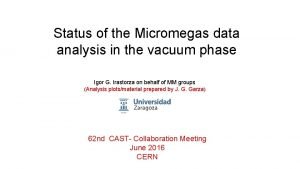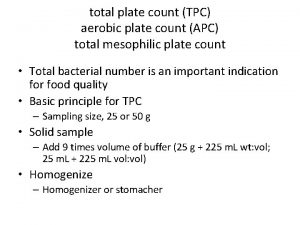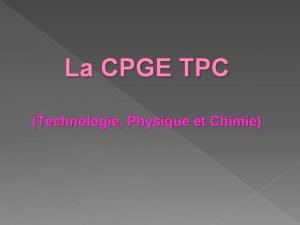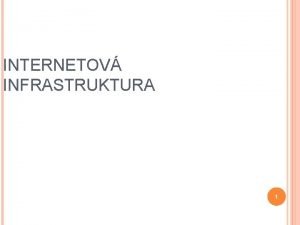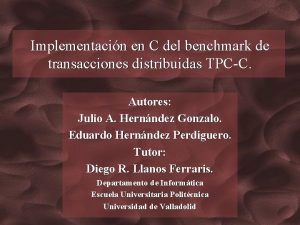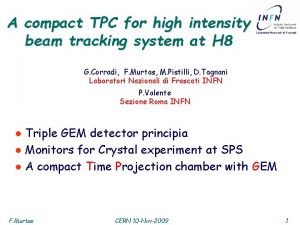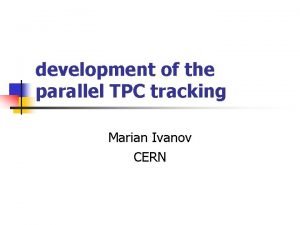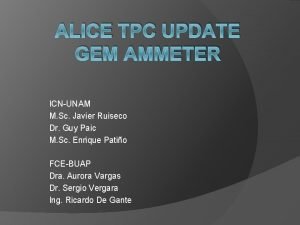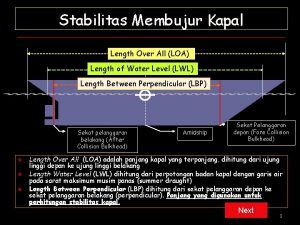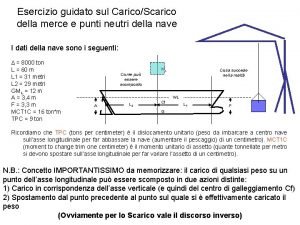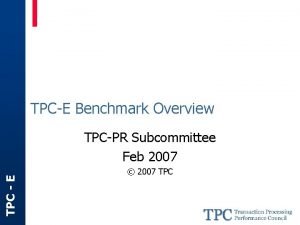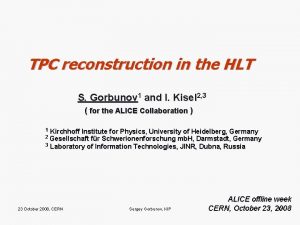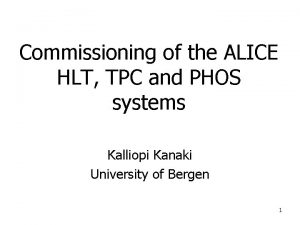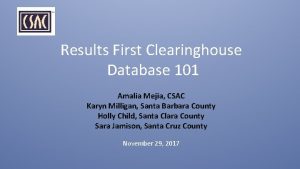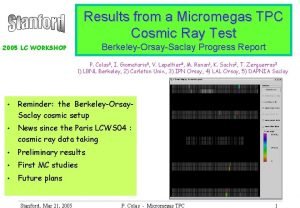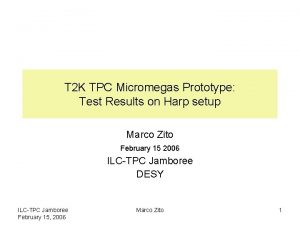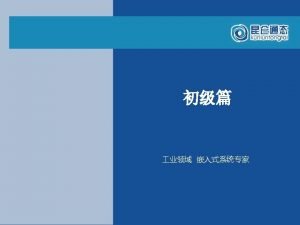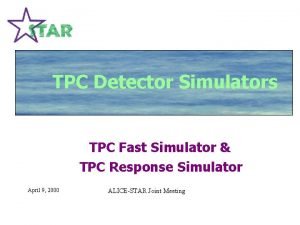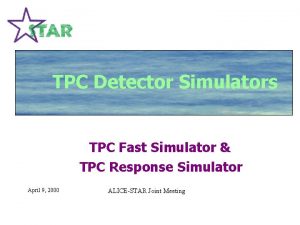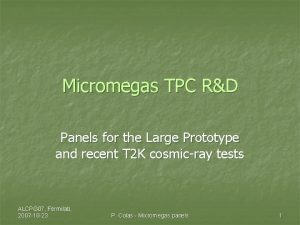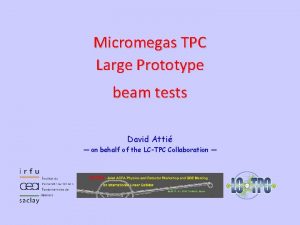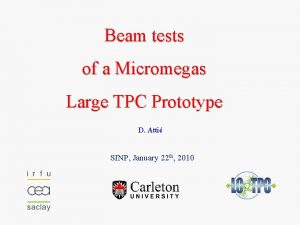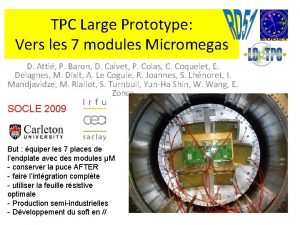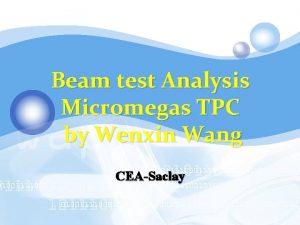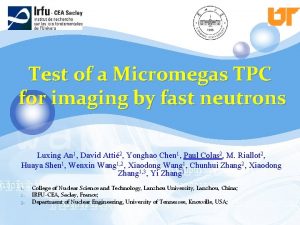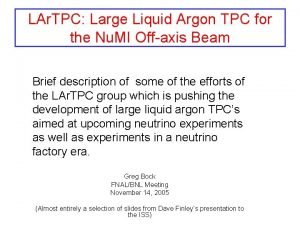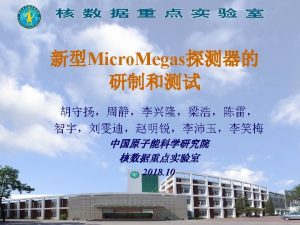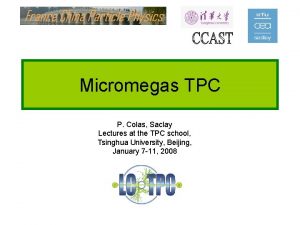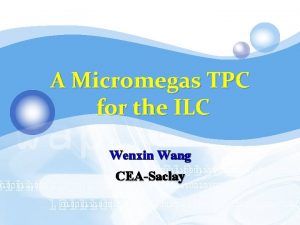FIRST TEST RESULTS FROM A MICROMEGAS LARGE TPC


















- Slides: 18

FIRST TEST RESULTS FROM A MICROMEGAS LARGE TPC PROTOTYPE P. Colas (CEA Saclay), on behalf of the LC-TPC collaboration Micromegas with resistive anode: previous results The Large Prototype Micromegas panels Data Drift velocity measurement Pad response function Resolution 12/03/2009, Tsukuba P. Colas, Micromegas TPC tests 1

Introduction : resistive anode LC-TPC goal is 200 measurement points on a track, with <130 micron resolution With Micromegas, signal spread is equal to the avalanche size, 12 -14 microns : not enough charge sharing at low diffusion even with 1 mm pads. Need to share the charge between neighbouring pads to make a barycentre possible and improve resolution. Also charge sharing saves number of channels ($, W, X°) 12/03/2009, Tsukuba D. Arogancia, K. Fujii et al. , to appear in NIM A P. Colas, Micromegas TPC tests 2

Introduction : resistive anode (2) One way to make charge sharing is to make a resistive anode (M. S. Dixit et. al. , NIM A 518 (2004) 721. ) This corresponds to adding a continuous RC circuit on top of the pad plane. Charge density obeys 2 D telegraph equation M. S. Dixit and A. Rankin NIM A 566 (2006) 281 SIMULATION MEASUREMENT Res. foil also provides anti-spark protection 12/03/2009, Tsukuba P. Colas, Micromegas TPC tests 3

Previous tests Micromegas TPC endplates have been tested in the past 1) Berkeley-Orsay-Saclay in cosmics, 2 T, 1000 channels (2002 -2004) 2) MP-TPC at KEK, 1 T, 380 channels (June 2005) 3) Carleton-Saclay chamber at KEK, 1 T, 128 channels with resistive anode (10/05) 4) Carleton-Saclay chamber at DESY 5 T in cosmics, 128 channels with r. a. Now test 1 panel in 1 T at DESY, 1726 channels (T 2 K electronics) 12/03/2009, Tsukuba P. Colas, Micromegas TPC tests 4

Previous results with resistive anodes KEK beam test, 2005 DESY 5 T cosmic test, 2007 50 micron resolution at short drift distance, with 2 mm pads (was obtained with an Al. Si cermet-coated mylar) 12/03/2009, Tsukuba P. Colas, Micromegas TPC tests 5

The EUDET setup at DESY See talk by K. Dehmelt PCMag magnet from KEK Cosmic trigger hodoscope from Saclay-KEK-INR Beam trigger from Nikhef Dummy modules from Bonn Field cage, gas from DESY Endplate from Cornell Test one Micromegas module at a time 12/03/2009, Tsukuba P. Colas, Micromegas TPC tests 6

Two panels have been tested at DESY Both in ‘bulk’ technology One with standard pads, one with resistive anode (Carbon-loaded kapton) Improved resistive anode 75 micron kapton + 25 micron C-loaded kapton (CERN) RESULTS Other 2 ready/ in preparation : resistive ink and thin-layer deposit (N. Wyrsch, Neuchatel) 12/03/2009, Tsukuba P. Colas, Micromegas TPC tests 7

Detector and electronics - 24 x 72 pads of 3 x 7 mm² - AFTER-based electronics : low-noise (700 e-) pre-amplifiershaper, 100 ns to 2 µs tunable peaking time, full wave sampling by SCA, frequency tunable from 1 to 100 MHz (most data at 25 MHz), 12 bit ADC (rms pedestals 4 to 6 channels) - Beam data (5 Ge. V electrons) were taken at several z values by sliding the TPC in the magnet. Beam size was 4 mm rms. 12/03/2009, Tsukuba P. Colas, Micromegas TPC tests 8

12/03/2009, Tsukuba P. Colas, Micromegas TPC tests 9

Cosmic ray data sample • Peaking time: 1 μs • Frequency sampling: 100 MHz 12/03/2009, Tsukuba P. Colas, Micromegas TPC tests 10 10

Measured drift velocity (Edrift = 230 V/cm, 1002 mbar) : 7. 56 ± 0. 02 cm/µs Magboltz : 7. 548 ± 0. 003 pour Ar: CF 4: isobutane: H 2 O/95: 3: 2: 100 ppm Drift time (µs) B=0 data Z (mm) arbitrary origin 12/03/2009, Tsukuba P. Colas, Micromegas TPC tests 11

Displacement wrt vertical straight line (microns) B=0 data Pad line number Rms displacement: 9 microns DESY - 8 déc. 2009 TPC Analysis 12

B=1 T data for several peaking time settings 200 ns, 500 ns, 1 µs, 2µs Edrift = 220 V/cm Magboltz 76 m/ns 12/03/2009, Tsukuba Edrift = 140 V/cm Magboltz 59 m/ns P. Colas, Micromegas TPC tests 13

Determination of the Pad Response Function Fraction of the row charge on a pad vs xpad – xtrack (normalized to central pad charge) Clearly shows charge spreading over 2 -3 pads (use data with 500 ns shaping) Then fit x(cluster) using this shape with a c² fit, and fit simultaneously all lines to a circle in the xy plane 12/03/2009, Tsukuba P. Colas, Micromegas TPC tests xpad – xtrack (mm) 14

RESIDUALS (z=10 cm) Do not use lines 0 -4 and 19 -23 for the time being (non gaussian residuals, magnetic field inhomogeneous for some z positions? ) 12/03/2009, Tsukuba P. Colas, Micromegas TPC tests 15

There is a residual bias of up to 50 micron, with a periodicity of about 3 mm. Effect of the analysis? Or detector effect : pillars? Inhomogeneity of RC? 12/03/2009, Tsukuba P. Colas, Micromegas TPC tests 16

Resolution 46± 6 microns with 2. 7 -3. 2 mm pads Effective number of electrons 23. 3± 3. 0 consistent with expectations 12/03/2009, Tsukuba P. Colas, Micromegas TPC tests 17

CONCLUSION • Excellent start for the Micromegas TPC tests within the EUDET facility. Smooth data taking • First analysis results confirm excellent resolution at small distance: 50 microns for 3 mm pads • Expect even better results with new (bypassed shaper) AFTER chips • Plans are to test several resistive layer fabrication, then go to 7 modules with integrated electronics 12/03/2009, Tsukuba P. Colas, Micromegas TPC tests 18
 Micromegas analysis
Micromegas analysis Tpc vs apc
Tpc vs apc Prépa tpc montpellier
Prépa tpc montpellier Rand internet
Rand internet Tpc-c benchmark
Tpc-c benchmark Rumus fwa dan dwa
Rumus fwa dan dwa Tpc traking
Tpc traking Tpc kink
Tpc kink Tpc.msc
Tpc.msc Length over
Length over Dislocamento unitario tpc
Dislocamento unitario tpc Tpcpr
Tpcpr Tpc global tracking
Tpc global tracking Tpc online tracking
Tpc online tracking Results first clearinghouse database
Results first clearinghouse database Christian love language test
Christian love language test Love language test
Love language test Famous yellow personalities
Famous yellow personalities Color code personality test
Color code personality test
